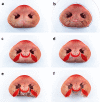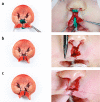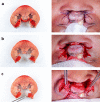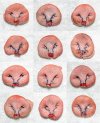An ex vivo model for education and training of bilateral cleft lip surgery
- PMID: 37596574
- PMCID: PMC10436624
- DOI: 10.1186/s12909-023-04575-9
An ex vivo model for education and training of bilateral cleft lip surgery
Abstract
Background: Bilateral cleft lip surgery is very challenging and requires a high level of skill, knowledge and experience. Existing high-fidelity simulation models that can be used by novice cleft surgeons to gain experience and expand their knowledge are rare and expensive. In this study, we developed a bilateral cleft lip model using porcine snout discs, which are available anywhere and inexpensive.
Methods: Anatomic reference points of a patient with a bilateral cleft lip were superimposed with landmarks of the porcine snout disc on a foil template. The template was used to construct an ex vivo bilateral cleft lip model. Surgery was performed on the model according to Millard and the surgical steps were photodocumented analogous to two clinical cases of bilateral cleft lip surgery. The suitability of the model was further tested by twelve participants and evaluated using self-assessment questionnaires.
Results: The bilateral cleft lip ex vivo model made of a porcine snout disc proved to be a suitable model with very low cost and ease of fabrication, as the template is reusable on any snout disc. The Millard procedure was successfully performed and the surgical steps of the lip plasty were simulated close to the clinical situation. Regarding the nasal reconstruction, the model lacks three-dimensionality. As a training model, it enhanced the participants comprehension of cleft surgery as well as their surgical skills. All participants rated the model as valuable for teaching and training.
Conclusions: The porcine snout discs can be used as a useful ex vivo model for bilateral cleft lip surgery with limitations in the construction of the nose, which cannot be realistically performed with the model due to anatomical differences with humans. Benefits include a realistic tissue feel, the simulation of a multi-layered lip construction, a wide and rapid availability and low cost. This allows the model to be used by novice surgeons also in low-income countries. It is therefore useful as a training model for gaining experience, but also as a model for refining, testing and evaluating surgical techniques for bilateral lip plasty.
Keywords: Bilateral cleft lip; Cadaver model; Cheiloplasty; Ex vivo model; Lip plasty; Porcine snout disc; Residency training; Skills lab; Surgical simulation; Teaching.
© 2023. BioMed Central Ltd., part of Springer Nature.
Conflict of interest statement
The authors declare no competing interests.
Figures











References
-
- Nadjmi N. Primary unilateral cleft lip-nose repair. In: Nadjmi N, editor. Surgical Management of Cleft lip and palate: a Comprehensive Atlas. Cham: Springer International Publishing; 2018. p. 44.
-
- Millard DR. Jr. Cleft craft: the evolution of its surgery—volume II: bilateral and rare deformities. Boston: Little Brown and Company; 1977.
MeSH terms
LinkOut - more resources
Full Text Sources
Medical
Research Materials
Miscellaneous

